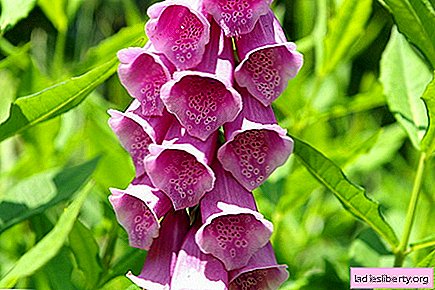
Digitalis - general description
Digitalis (digitalis Digitális) herbaceous plant, perennial or biennial grass belonging to the Podorozhnikov family. It has a hard tall stalk, up to 150 cm high, unbranched. Whole-edge, lanceolate leaves are attached in the next way, gradually turning into bracts.
The flowers are irregularly shaped, yellow, purple or reddish in color, collected in apical, dense, unilateral or multilateral racemose inflorescences. Corollas are bell-shaped, spherically swollen. The flowering period is June-August. Fruit - a box in which there are small brown seeds that can germinate within 3 years.
The beauty of this plant should not confuse you - it is very poisonous!
Digitalis - types and places of growth
This plant has about 35 species that grow in areas of the Mediterranean. Digitalis can also be found in Europe and West Asia, it grows in the northern regions of Africa. On the territory of the USSR, there are 4 species, only the Caucasus has 4 species of plants. The main varieties: digitalis is rusty, large-flowered, woolly, large-flowered. The plant prefers deciduous and mixed forests, edges, glades.
Digitalis - healing properties
This medicinal herb is recognized as one of the most important heart medicines; it treats severe circulatory disorders and chronic heart failure. It is used for hypertension and edema formed with a disorder of cardiac activity. Digitalis medications cannot be used for a long time, but it is perfectly absorbed and has a gentle effect on the gastrointestinal tract. The maximum effect is observed within 8-12 hours. Preparations from this medicinal plant reduce shortness of breath, normalize the pulse, and the general condition of the patient improves significantly.
Digitalis - dosage forms
Official medicine widely uses digitalis in pharmacology. These are drugs with which heart diseases are treated - Gitalin, Digipuren, Lantozid, Cordigid, Digitoxin, digitalis leaves and dry herb extract in tablets.
In folk medicine, the terrestrial parts of the plant, leaves, stems and flowers are used. They can be collected in the first year of life of the plant several times a season. Pharmacology obtains from the leaves digitoxin and gitoxin in crystalline form, and the substance cordigide, which is the sum of all glycosides. Most often, purple and large-flowered digitalis are used for this.
Another variety - woolly digitalis is used to obtain drugs that regulate the activity of the heart muscle, obtained from celanide, acetyldigitoxin contained in this variety of grass. In traditional medicine, infusions and decoctions of purple digitalis are used. The powder from its leaves is used for wound healing and is used for hysteria and other nervous disorders.
Digitalis - recipes
Infusion of crushed leaves of a plant: 1 gram of raw material is infused in 180 ml of water. Children are given a less concentrated solution (half the adult dose) and given a teaspoon dessert spoon for heart disease. Do not self-medicate with these infusions, it is better to use ready-made medicines by prescription.
Digitalis - contraindications
Although some drugs are used with long-term treatment, the herb tends to accumulate in the body. Glycosides are very slowly excreted, a large concentration of digitalis in the body can cause poisoning, so when taking medications, it is necessary to observe a doctor.
This deadly poisonous plant can cause poisoning, the symptoms of which are blue lips and nausea, arrhythmia, diarrhea, suffocation and vomiting. With these signs, it is required to immediately empty the stomach and take activated charcoal. A categorical contraindication is the following diseases: coronary insufficiency, heart disease, myocardial infarction, bradycardia, infectious diseases.
Safe consumption of drugs is achieved by alternating digitalis with other heart medicines.
Comments











